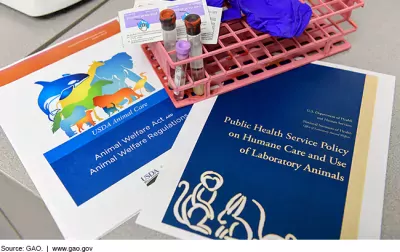Animal Research in the Federal Government: A Search for Alternatives
Researchers have frequently used animals to study disease, test product safety, experiment, or teach. Such research has led to countless breakthroughs, including advances in medical treatments and surgical procedures, life-saving medications and vaccines, and consumer product safety to name a few.
But there’s a growing number of alternatives available that let researchers replace, reduce, or refine their use of animals for research and testing.
In today’s WatchBlog, we look at how the federal government is helping to ensure the humane treatment of research animals and how agencies are promoting and developing alternatives to animal testing.
Using data to track animal welfare
About 20 federal agencies use animals for research—much of which focuses on human health and medicine, but also includes testing for agriculture, animal health, and product safety.
As a check on their practices, agencies must provide data to the National Institutes of Health and the Animal and Plant Health Inspection Service about how they use and care for animals, including
- the number of animals agencies use that are covered by the Animal Welfare Act (e.g., warm-blooded animals like dogs, cats, and monkeys)
- proof that agencies comply with animal welfare standards
- plans for how agencies alleviate animal pain or distress
In our 2018 report, we found that while research facilities submitted required information to the NIH, facilities were not accurately reporting their animal use to the APHIS because of inadequate instructions. We made recommendations at that time—3 of which are currently open.
Developing alternatives to animal use in testing
Federal agencies require researchers to consider alternatives to animal use. For example, instead of animals, researchers can use computer modeling to predict how humans will be affected by certain chemicals. Federal agencies have also collaborated to develop devices that could help reduce animal testing, such as the tissue chip pictured below, which contains features designed to replicate the complex biological functions of specific human organs.
Researchers and federal agencies are looking to promote alternatives to animal use for several reasons:
- a desire and need to protect the animals
- the potential to find more accurate information about human diseases or health than animal research can provide
- the potential to lower costs and decrease the time needed to conduct research than possible with animal use
We identified 3 key agencies—Health and Human Services, the Department of Agriculture, and the Environmental Protection Agency—that conduct or fund research that doesn’t use animals or uses fewer animals. For example, HHS provided funding to scientists to test chemicals for toxicity using human cell cultures rather than animals.
Some agencies also encourage industry to use alternatives when conducting product safety research. For example, the EPA issued a strategic plan to reduce animal testing for toxic chemicals and pesticides.
In addition, the 3 agencies collaborate and share best practices in animal use alternatives and have developed a roadmap to identify the progress they have individually or collectively made toward reducing, refining, or replacing animal use in testing. However, we found that the agencies have not routinely measured the effect of their efforts.
We recommended that HHS create a workgroup to help the agencies assess and report on their progress in reducing or replacing animal use in research.
Want to know more? Check out the full 2018 report and our full 2019 report.
Comments on GAO’s WatchBlog? Contact blog@gao.gov.
GAO Contacts
Related Products

GAO's mission is to provide Congress with fact-based, nonpartisan information that can help improve federal government performance and ensure accountability for the benefit of the American people. GAO launched its WatchBlog in January, 2014, as part of its continuing effort to reach its audiences—Congress and the American people—where they are currently looking for information.
The blog format allows GAO to provide a little more context about its work than it can offer on its other social media platforms. Posts will tie GAO work to current events and the news; show how GAO’s work is affecting agencies or legislation; highlight reports, testimonies, and issue areas where GAO does work; and provide information about GAO itself, among other things.
Please send any feedback on GAO's WatchBlog to blog@gao.gov.



